Research Proposal: Voluntary Disclosure of Environmental Performance
VerifiedAdded on 2021/04/16
|7
|2056
|26
Report
AI Summary
This research proposal, prepared by a student, investigates the voluntary disclosure of environmental performance, focusing on carbon emissions and their impact. The literature review covers climate change, carbon disclosure, and the role of corporate governance, board of directors, and stakeholder management. It examines the relationship between carbon emissions and the environment, the effects of greenhouse gas emissions, and the use of carbon footprint calculations. The study proposes a conceptual model and hypotheses, including proxy measures for theoretical constructs such as firm ownership, board diversity, and profitability. The research methodology involves descriptive research design, mixed data collection methods (primary and secondary), and quantitative data analysis using surveys and emission factors. The proposal references relevant standards like ISO 14064 and IPCC guidelines, aiming to analyze carbon emissions and corporate environmental responsibility.
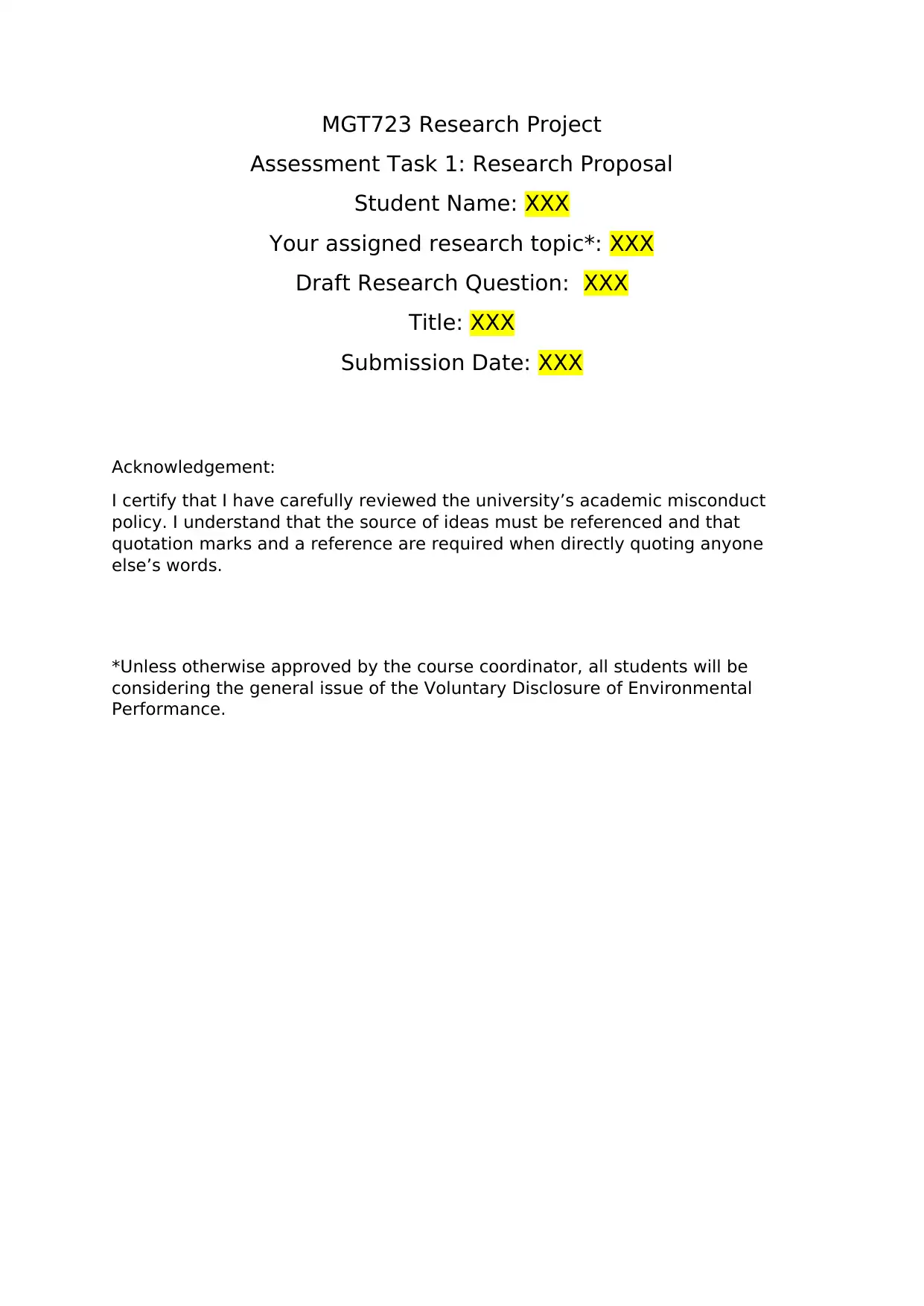
MGT723 Research Project
Assessment Task 1: Research Proposal
Student Name: XXX
Your assigned research topic*: XXX
Draft Research Question: XXX
Title: XXX
Submission Date: XXX
Acknowledgement:
I certify that I have carefully reviewed the university’s academic misconduct
policy. I understand that the source of ideas must be referenced and that
quotation marks and a reference are required when directly quoting anyone
else’s words.
*Unless otherwise approved by the course coordinator, all students will be
considering the general issue of the Voluntary Disclosure of Environmental
Performance.
Assessment Task 1: Research Proposal
Student Name: XXX
Your assigned research topic*: XXX
Draft Research Question: XXX
Title: XXX
Submission Date: XXX
Acknowledgement:
I certify that I have carefully reviewed the university’s academic misconduct
policy. I understand that the source of ideas must be referenced and that
quotation marks and a reference are required when directly quoting anyone
else’s words.
*Unless otherwise approved by the course coordinator, all students will be
considering the general issue of the Voluntary Disclosure of Environmental
Performance.
Paraphrase This Document
Need a fresh take? Get an instant paraphrase of this document with our AI Paraphraser
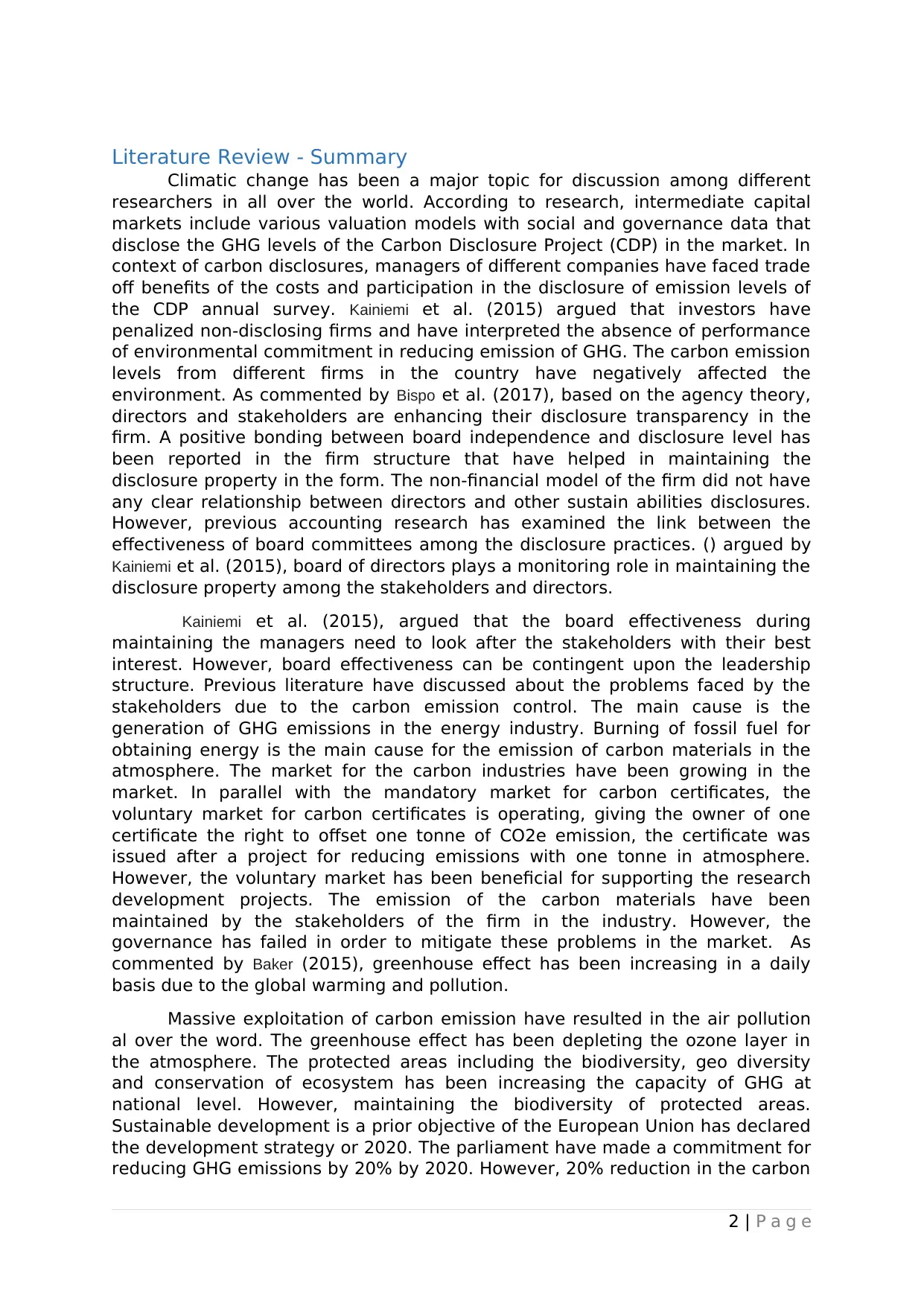
Literature Review - Summary
Climatic change has been a major topic for discussion among different
researchers in all over the world. According to research, intermediate capital
markets include various valuation models with social and governance data that
disclose the GHG levels of the Carbon Disclosure Project (CDP) in the market. In
context of carbon disclosures, managers of different companies have faced trade
off benefits of the costs and participation in the disclosure of emission levels of
the CDP annual survey. Kainiemi et al. (2015) argued that investors have
penalized non-disclosing firms and have interpreted the absence of performance
of environmental commitment in reducing emission of GHG. The carbon emission
levels from different firms in the country have negatively affected the
environment. As commented by Bispo et al. (2017), based on the agency theory,
directors and stakeholders are enhancing their disclosure transparency in the
firm. A positive bonding between board independence and disclosure level has
been reported in the firm structure that have helped in maintaining the
disclosure property in the form. The non-financial model of the firm did not have
any clear relationship between directors and other sustain abilities disclosures.
However, previous accounting research has examined the link between the
effectiveness of board committees among the disclosure practices. () argued by
Kainiemi et al. (2015), board of directors plays a monitoring role in maintaining the
disclosure property among the stakeholders and directors.
Kainiemi et al. (2015), argued that the board effectiveness during
maintaining the managers need to look after the stakeholders with their best
interest. However, board effectiveness can be contingent upon the leadership
structure. Previous literature have discussed about the problems faced by the
stakeholders due to the carbon emission control. The main cause is the
generation of GHG emissions in the energy industry. Burning of fossil fuel for
obtaining energy is the main cause for the emission of carbon materials in the
atmosphere. The market for the carbon industries have been growing in the
market. In parallel with the mandatory market for carbon certificates, the
voluntary market for carbon certificates is operating, giving the owner of one
certificate the right to offset one tonne of CO2e emission, the certificate was
issued after a project for reducing emissions with one tonne in atmosphere.
However, the voluntary market has been beneficial for supporting the research
development projects. The emission of the carbon materials have been
maintained by the stakeholders of the firm in the industry. However, the
governance has failed in order to mitigate these problems in the market. As
commented by Baker (2015), greenhouse effect has been increasing in a daily
basis due to the global warming and pollution.
Massive exploitation of carbon emission have resulted in the air pollution
al over the word. The greenhouse effect has been depleting the ozone layer in
the atmosphere. The protected areas including the biodiversity, geo diversity
and conservation of ecosystem has been increasing the capacity of GHG at
national level. However, maintaining the biodiversity of protected areas.
Sustainable development is a prior objective of the European Union has declared
the development strategy or 2020. The parliament have made a commitment for
reducing GHG emissions by 20% by 2020. However, 20% reduction in the carbon
2 | P a g e
Climatic change has been a major topic for discussion among different
researchers in all over the world. According to research, intermediate capital
markets include various valuation models with social and governance data that
disclose the GHG levels of the Carbon Disclosure Project (CDP) in the market. In
context of carbon disclosures, managers of different companies have faced trade
off benefits of the costs and participation in the disclosure of emission levels of
the CDP annual survey. Kainiemi et al. (2015) argued that investors have
penalized non-disclosing firms and have interpreted the absence of performance
of environmental commitment in reducing emission of GHG. The carbon emission
levels from different firms in the country have negatively affected the
environment. As commented by Bispo et al. (2017), based on the agency theory,
directors and stakeholders are enhancing their disclosure transparency in the
firm. A positive bonding between board independence and disclosure level has
been reported in the firm structure that have helped in maintaining the
disclosure property in the form. The non-financial model of the firm did not have
any clear relationship between directors and other sustain abilities disclosures.
However, previous accounting research has examined the link between the
effectiveness of board committees among the disclosure practices. () argued by
Kainiemi et al. (2015), board of directors plays a monitoring role in maintaining the
disclosure property among the stakeholders and directors.
Kainiemi et al. (2015), argued that the board effectiveness during
maintaining the managers need to look after the stakeholders with their best
interest. However, board effectiveness can be contingent upon the leadership
structure. Previous literature have discussed about the problems faced by the
stakeholders due to the carbon emission control. The main cause is the
generation of GHG emissions in the energy industry. Burning of fossil fuel for
obtaining energy is the main cause for the emission of carbon materials in the
atmosphere. The market for the carbon industries have been growing in the
market. In parallel with the mandatory market for carbon certificates, the
voluntary market for carbon certificates is operating, giving the owner of one
certificate the right to offset one tonne of CO2e emission, the certificate was
issued after a project for reducing emissions with one tonne in atmosphere.
However, the voluntary market has been beneficial for supporting the research
development projects. The emission of the carbon materials have been
maintained by the stakeholders of the firm in the industry. However, the
governance has failed in order to mitigate these problems in the market. As
commented by Baker (2015), greenhouse effect has been increasing in a daily
basis due to the global warming and pollution.
Massive exploitation of carbon emission have resulted in the air pollution
al over the word. The greenhouse effect has been depleting the ozone layer in
the atmosphere. The protected areas including the biodiversity, geo diversity
and conservation of ecosystem has been increasing the capacity of GHG at
national level. However, maintaining the biodiversity of protected areas.
Sustainable development is a prior objective of the European Union has declared
the development strategy or 2020. The parliament have made a commitment for
reducing GHG emissions by 20% by 2020. However, 20% reduction in the carbon
2 | P a g e
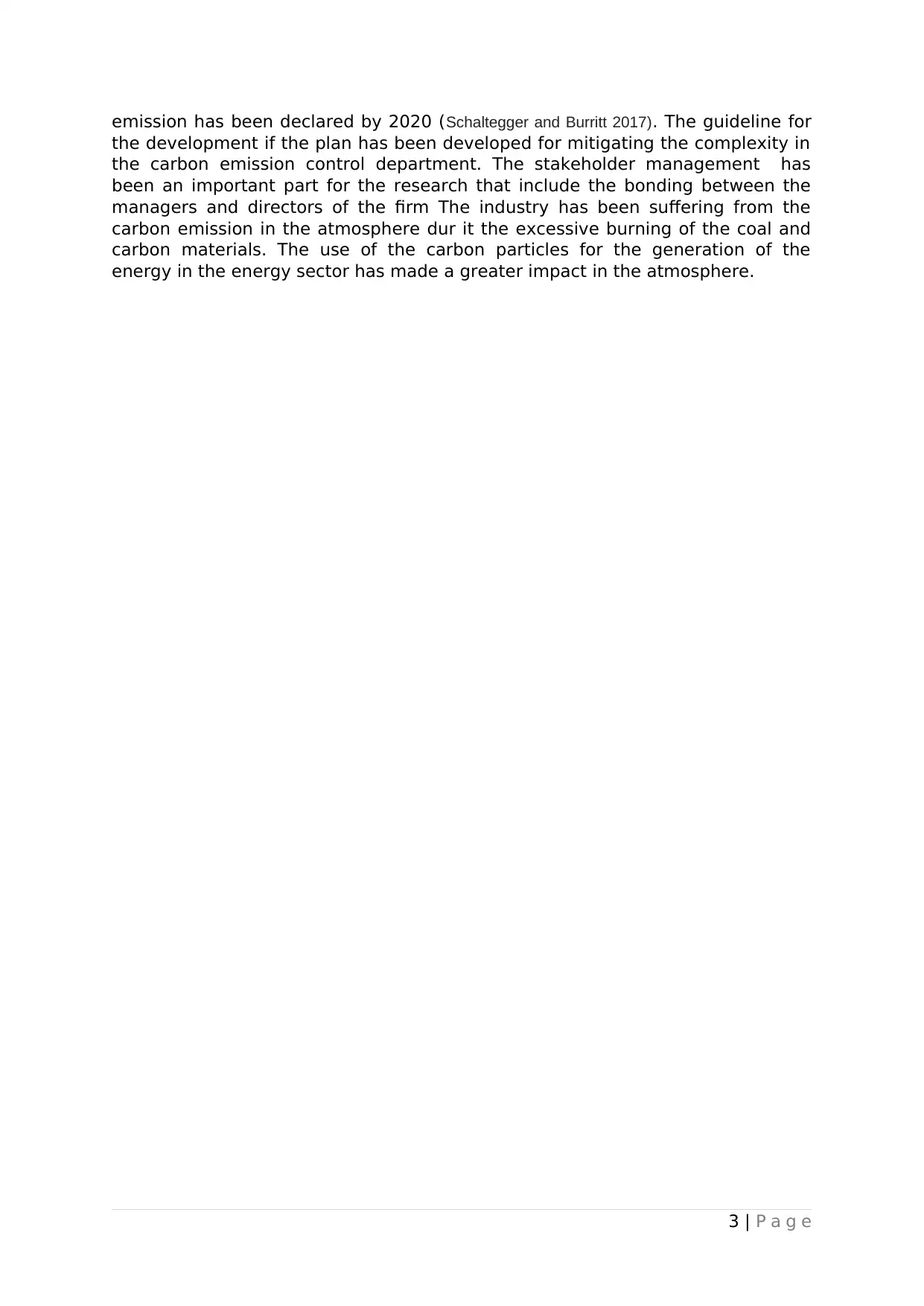
emission has been declared by 2020 (Schaltegger and Burritt 2017). The guideline for
the development if the plan has been developed for mitigating the complexity in
the carbon emission control department. The stakeholder management has
been an important part for the research that include the bonding between the
managers and directors of the firm The industry has been suffering from the
carbon emission in the atmosphere dur it the excessive burning of the coal and
carbon materials. The use of the carbon particles for the generation of the
energy in the energy sector has made a greater impact in the atmosphere.
3 | P a g e
the development if the plan has been developed for mitigating the complexity in
the carbon emission control department. The stakeholder management has
been an important part for the research that include the bonding between the
managers and directors of the firm The industry has been suffering from the
carbon emission in the atmosphere dur it the excessive burning of the coal and
carbon materials. The use of the carbon particles for the generation of the
energy in the energy sector has made a greater impact in the atmosphere.
3 | P a g e
⊘ This is a preview!⊘
Do you want full access?
Subscribe today to unlock all pages.

Trusted by 1+ million students worldwide
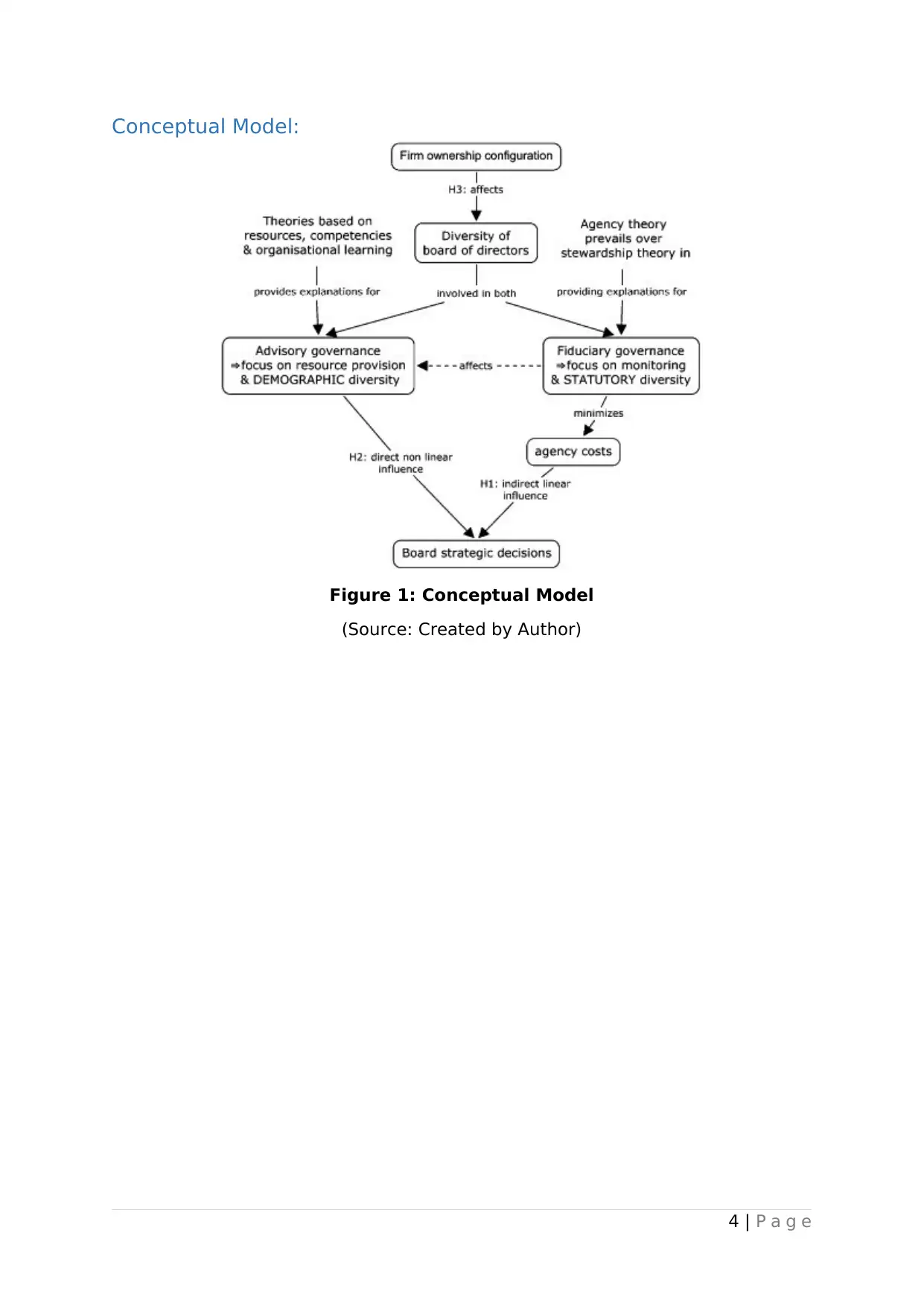
Conceptual Model:
Figure 1: Conceptual Model
(Source: Created by Author)
4 | P a g e
Figure 1: Conceptual Model
(Source: Created by Author)
4 | P a g e
Paraphrase This Document
Need a fresh take? Get an instant paraphrase of this document with our AI Paraphraser
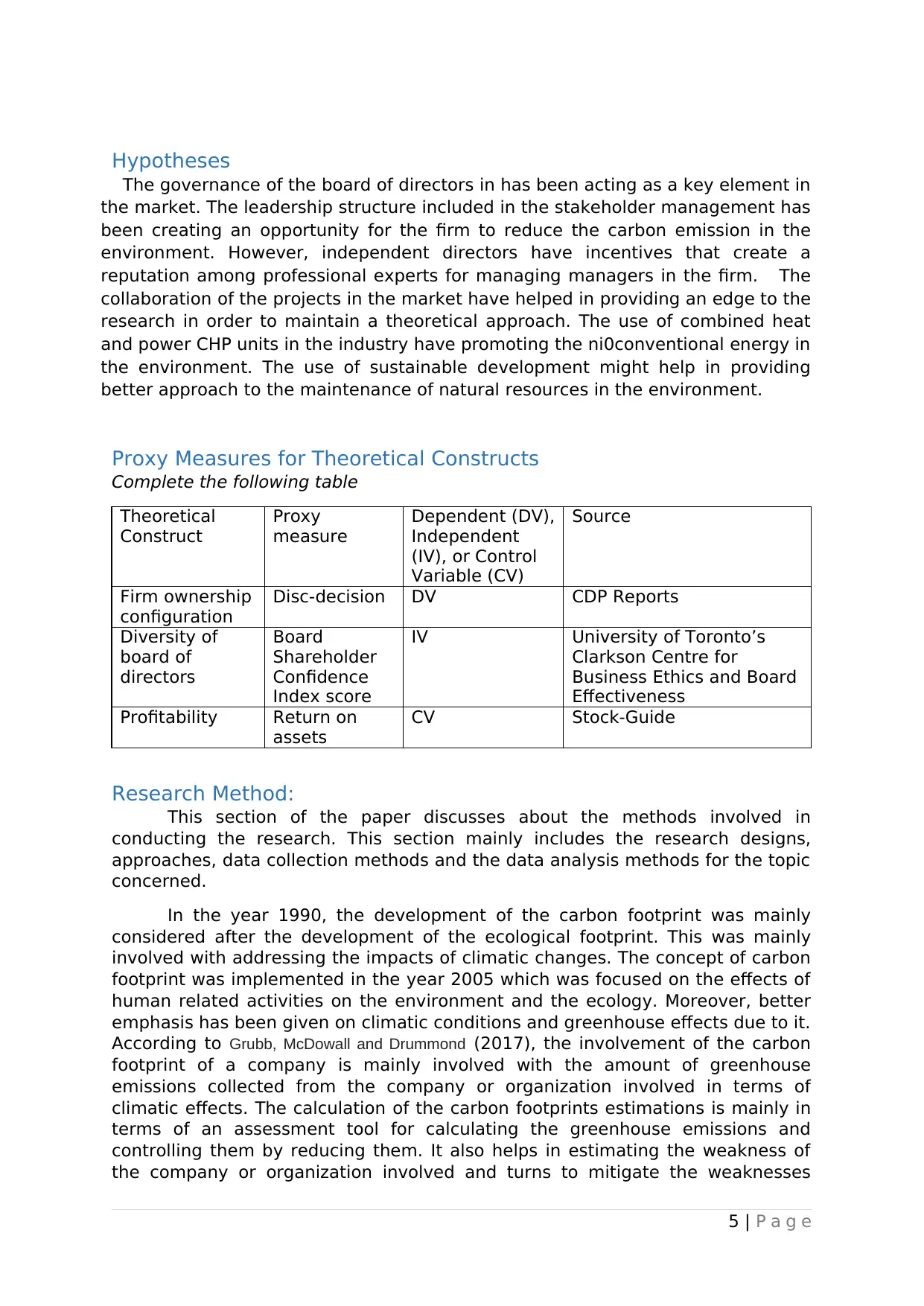
Hypotheses
The governance of the board of directors in has been acting as a key element in
the market. The leadership structure included in the stakeholder management has
been creating an opportunity for the firm to reduce the carbon emission in the
environment. However, independent directors have incentives that create a
reputation among professional experts for managing managers in the firm. The
collaboration of the projects in the market have helped in providing an edge to the
research in order to maintain a theoretical approach. The use of combined heat
and power CHP units in the industry have promoting the ni0conventional energy in
the environment. The use of sustainable development might help in providing
better approach to the maintenance of natural resources in the environment.
Proxy Measures for Theoretical Constructs
Complete the following table
Theoretical
Construct
Proxy
measure
Dependent (DV),
Independent
(IV), or Control
Variable (CV)
Source
Firm ownership
configuration
Disc-decision DV CDP Reports
Diversity of
board of
directors
Board
Shareholder
Confidence
Index score
IV University of Toronto’s
Clarkson Centre for
Business Ethics and Board
Effectiveness
Profitability Return on
assets
CV Stock-Guide
Research Method:
This section of the paper discusses about the methods involved in
conducting the research. This section mainly includes the research designs,
approaches, data collection methods and the data analysis methods for the topic
concerned.
In the year 1990, the development of the carbon footprint was mainly
considered after the development of the ecological footprint. This was mainly
involved with addressing the impacts of climatic changes. The concept of carbon
footprint was implemented in the year 2005 which was focused on the effects of
human related activities on the environment and the ecology. Moreover, better
emphasis has been given on climatic conditions and greenhouse effects due to it.
According to Grubb, McDowall and Drummond (2017), the involvement of the carbon
footprint of a company is mainly involved with the amount of greenhouse
emissions collected from the company or organization involved in terms of
climatic effects. The calculation of the carbon footprints estimations is mainly in
terms of an assessment tool for calculating the greenhouse emissions and
controlling them by reducing them. It also helps in estimating the weakness of
the company or organization involved and turns to mitigate the weaknesses
5 | P a g e
The governance of the board of directors in has been acting as a key element in
the market. The leadership structure included in the stakeholder management has
been creating an opportunity for the firm to reduce the carbon emission in the
environment. However, independent directors have incentives that create a
reputation among professional experts for managing managers in the firm. The
collaboration of the projects in the market have helped in providing an edge to the
research in order to maintain a theoretical approach. The use of combined heat
and power CHP units in the industry have promoting the ni0conventional energy in
the environment. The use of sustainable development might help in providing
better approach to the maintenance of natural resources in the environment.
Proxy Measures for Theoretical Constructs
Complete the following table
Theoretical
Construct
Proxy
measure
Dependent (DV),
Independent
(IV), or Control
Variable (CV)
Source
Firm ownership
configuration
Disc-decision DV CDP Reports
Diversity of
board of
directors
Board
Shareholder
Confidence
Index score
IV University of Toronto’s
Clarkson Centre for
Business Ethics and Board
Effectiveness
Profitability Return on
assets
CV Stock-Guide
Research Method:
This section of the paper discusses about the methods involved in
conducting the research. This section mainly includes the research designs,
approaches, data collection methods and the data analysis methods for the topic
concerned.
In the year 1990, the development of the carbon footprint was mainly
considered after the development of the ecological footprint. This was mainly
involved with addressing the impacts of climatic changes. The concept of carbon
footprint was implemented in the year 2005 which was focused on the effects of
human related activities on the environment and the ecology. Moreover, better
emphasis has been given on climatic conditions and greenhouse effects due to it.
According to Grubb, McDowall and Drummond (2017), the involvement of the carbon
footprint of a company is mainly involved with the amount of greenhouse
emissions collected from the company or organization involved in terms of
climatic effects. The calculation of the carbon footprints estimations is mainly in
terms of an assessment tool for calculating the greenhouse emissions and
controlling them by reducing them. It also helps in estimating the weakness of
the company or organization involved and turns to mitigate the weaknesses
5 | P a g e
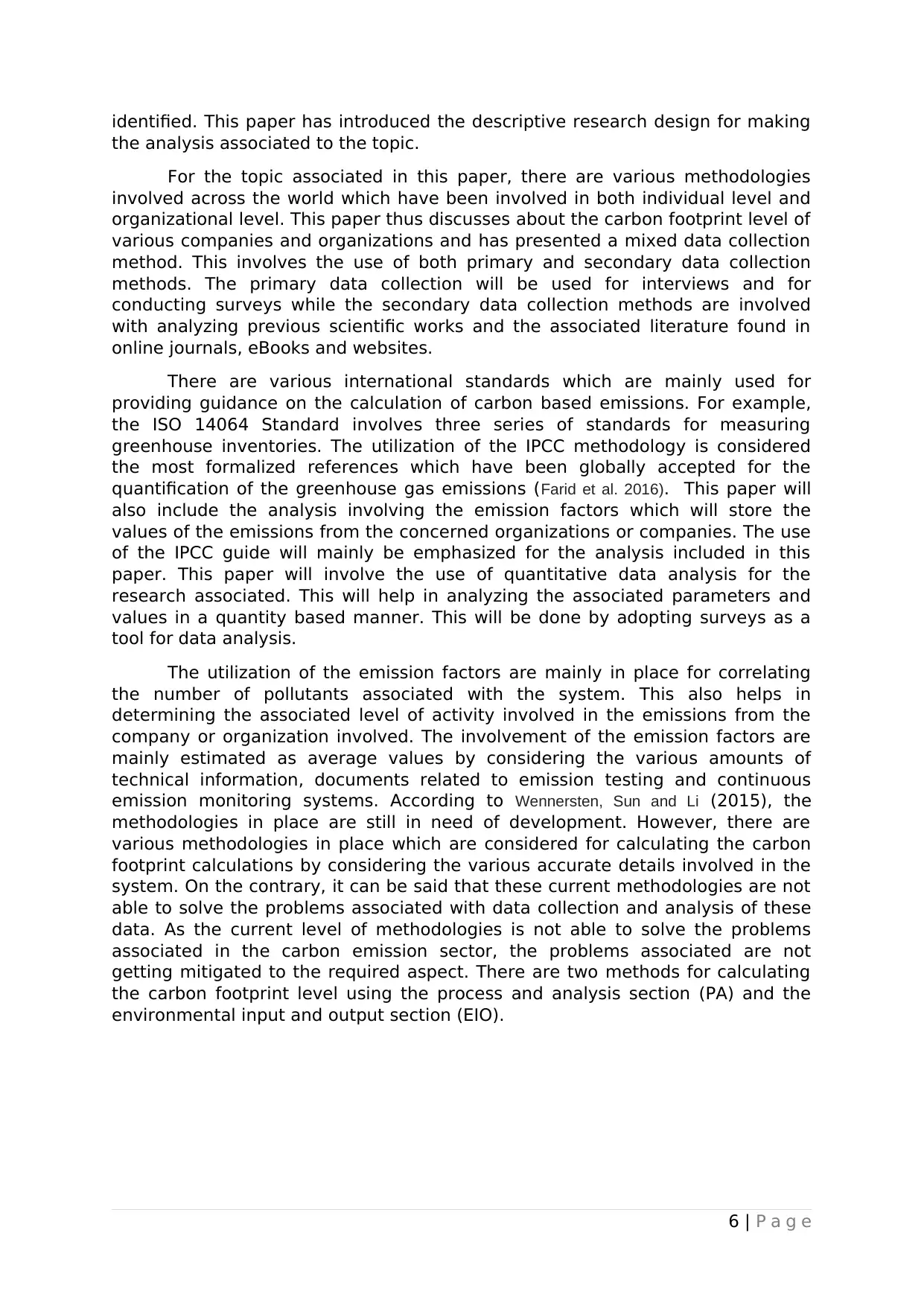
identified. This paper has introduced the descriptive research design for making
the analysis associated to the topic.
For the topic associated in this paper, there are various methodologies
involved across the world which have been involved in both individual level and
organizational level. This paper thus discusses about the carbon footprint level of
various companies and organizations and has presented a mixed data collection
method. This involves the use of both primary and secondary data collection
methods. The primary data collection will be used for interviews and for
conducting surveys while the secondary data collection methods are involved
with analyzing previous scientific works and the associated literature found in
online journals, eBooks and websites.
There are various international standards which are mainly used for
providing guidance on the calculation of carbon based emissions. For example,
the ISO 14064 Standard involves three series of standards for measuring
greenhouse inventories. The utilization of the IPCC methodology is considered
the most formalized references which have been globally accepted for the
quantification of the greenhouse gas emissions (Farid et al. 2016). This paper will
also include the analysis involving the emission factors which will store the
values of the emissions from the concerned organizations or companies. The use
of the IPCC guide will mainly be emphasized for the analysis included in this
paper. This paper will involve the use of quantitative data analysis for the
research associated. This will help in analyzing the associated parameters and
values in a quantity based manner. This will be done by adopting surveys as a
tool for data analysis.
The utilization of the emission factors are mainly in place for correlating
the number of pollutants associated with the system. This also helps in
determining the associated level of activity involved in the emissions from the
company or organization involved. The involvement of the emission factors are
mainly estimated as average values by considering the various amounts of
technical information, documents related to emission testing and continuous
emission monitoring systems. According to Wennersten, Sun and Li (2015), the
methodologies in place are still in need of development. However, there are
various methodologies in place which are considered for calculating the carbon
footprint calculations by considering the various accurate details involved in the
system. On the contrary, it can be said that these current methodologies are not
able to solve the problems associated with data collection and analysis of these
data. As the current level of methodologies is not able to solve the problems
associated in the carbon emission sector, the problems associated are not
getting mitigated to the required aspect. There are two methods for calculating
the carbon footprint level using the process and analysis section (PA) and the
environmental input and output section (EIO).
6 | P a g e
the analysis associated to the topic.
For the topic associated in this paper, there are various methodologies
involved across the world which have been involved in both individual level and
organizational level. This paper thus discusses about the carbon footprint level of
various companies and organizations and has presented a mixed data collection
method. This involves the use of both primary and secondary data collection
methods. The primary data collection will be used for interviews and for
conducting surveys while the secondary data collection methods are involved
with analyzing previous scientific works and the associated literature found in
online journals, eBooks and websites.
There are various international standards which are mainly used for
providing guidance on the calculation of carbon based emissions. For example,
the ISO 14064 Standard involves three series of standards for measuring
greenhouse inventories. The utilization of the IPCC methodology is considered
the most formalized references which have been globally accepted for the
quantification of the greenhouse gas emissions (Farid et al. 2016). This paper will
also include the analysis involving the emission factors which will store the
values of the emissions from the concerned organizations or companies. The use
of the IPCC guide will mainly be emphasized for the analysis included in this
paper. This paper will involve the use of quantitative data analysis for the
research associated. This will help in analyzing the associated parameters and
values in a quantity based manner. This will be done by adopting surveys as a
tool for data analysis.
The utilization of the emission factors are mainly in place for correlating
the number of pollutants associated with the system. This also helps in
determining the associated level of activity involved in the emissions from the
company or organization involved. The involvement of the emission factors are
mainly estimated as average values by considering the various amounts of
technical information, documents related to emission testing and continuous
emission monitoring systems. According to Wennersten, Sun and Li (2015), the
methodologies in place are still in need of development. However, there are
various methodologies in place which are considered for calculating the carbon
footprint calculations by considering the various accurate details involved in the
system. On the contrary, it can be said that these current methodologies are not
able to solve the problems associated with data collection and analysis of these
data. As the current level of methodologies is not able to solve the problems
associated in the carbon emission sector, the problems associated are not
getting mitigated to the required aspect. There are two methods for calculating
the carbon footprint level using the process and analysis section (PA) and the
environmental input and output section (EIO).
6 | P a g e
⊘ This is a preview!⊘
Do you want full access?
Subscribe today to unlock all pages.

Trusted by 1+ million students worldwide
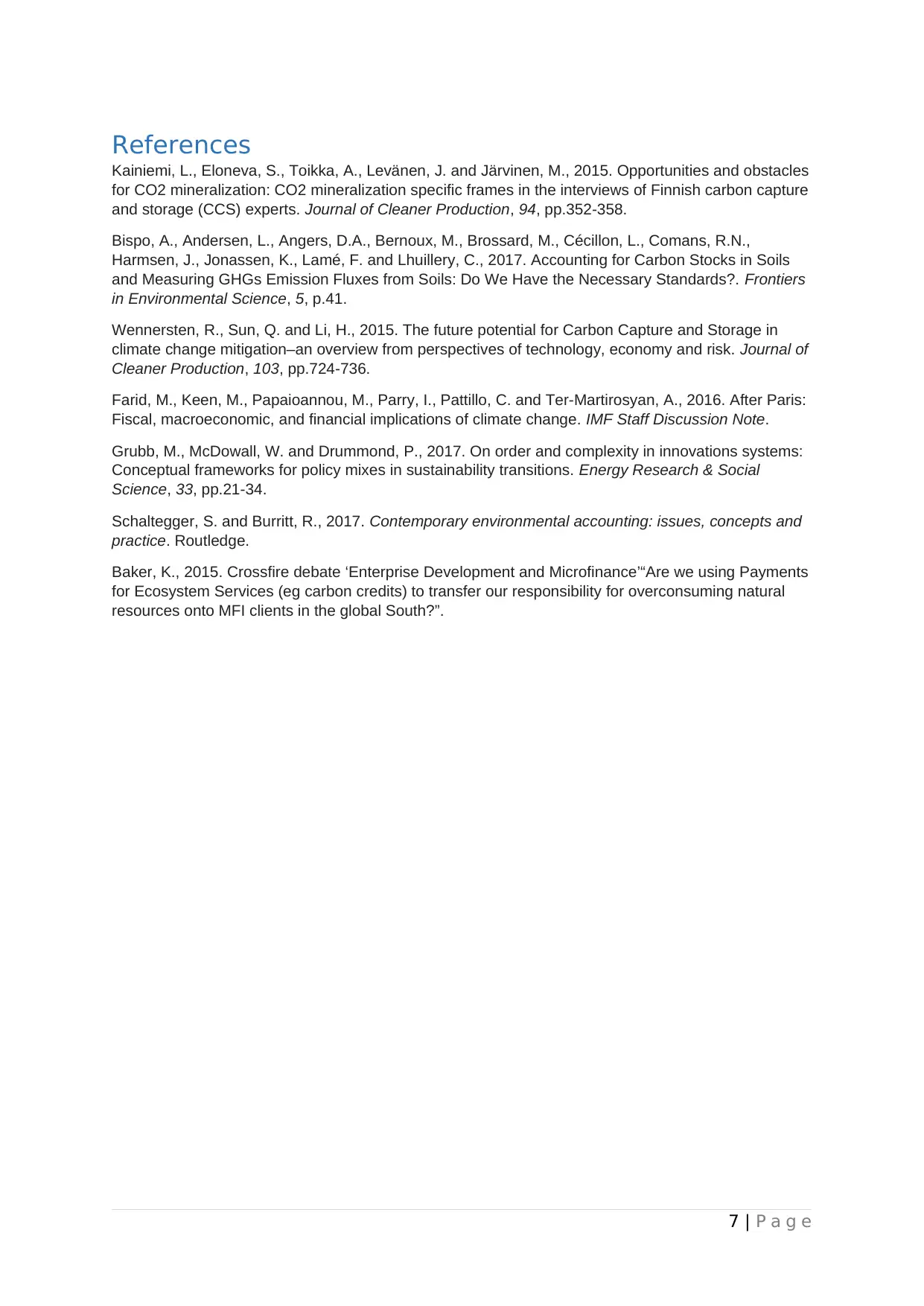
References
Kainiemi, L., Eloneva, S., Toikka, A., Levänen, J. and Järvinen, M., 2015. Opportunities and obstacles
for CO2 mineralization: CO2 mineralization specific frames in the interviews of Finnish carbon capture
and storage (CCS) experts. Journal of Cleaner Production, 94, pp.352-358.
Bispo, A., Andersen, L., Angers, D.A., Bernoux, M., Brossard, M., Cécillon, L., Comans, R.N.,
Harmsen, J., Jonassen, K., Lamé, F. and Lhuillery, C., 2017. Accounting for Carbon Stocks in Soils
and Measuring GHGs Emission Fluxes from Soils: Do We Have the Necessary Standards?. Frontiers
in Environmental Science, 5, p.41.
Wennersten, R., Sun, Q. and Li, H., 2015. The future potential for Carbon Capture and Storage in
climate change mitigation–an overview from perspectives of technology, economy and risk. Journal of
Cleaner Production, 103, pp.724-736.
Farid, M., Keen, M., Papaioannou, M., Parry, I., Pattillo, C. and Ter-Martirosyan, A., 2016. After Paris:
Fiscal, macroeconomic, and financial implications of climate change. IMF Staff Discussion Note.
Grubb, M., McDowall, W. and Drummond, P., 2017. On order and complexity in innovations systems:
Conceptual frameworks for policy mixes in sustainability transitions. Energy Research & Social
Science, 33, pp.21-34.
Schaltegger, S. and Burritt, R., 2017. Contemporary environmental accounting: issues, concepts and
practice. Routledge.
Baker, K., 2015. Crossfire debate ‘Enterprise Development and Microfinance’“Are we using Payments
for Ecosystem Services (eg carbon credits) to transfer our responsibility for overconsuming natural
resources onto MFI clients in the global South?”.
7 | P a g e
Kainiemi, L., Eloneva, S., Toikka, A., Levänen, J. and Järvinen, M., 2015. Opportunities and obstacles
for CO2 mineralization: CO2 mineralization specific frames in the interviews of Finnish carbon capture
and storage (CCS) experts. Journal of Cleaner Production, 94, pp.352-358.
Bispo, A., Andersen, L., Angers, D.A., Bernoux, M., Brossard, M., Cécillon, L., Comans, R.N.,
Harmsen, J., Jonassen, K., Lamé, F. and Lhuillery, C., 2017. Accounting for Carbon Stocks in Soils
and Measuring GHGs Emission Fluxes from Soils: Do We Have the Necessary Standards?. Frontiers
in Environmental Science, 5, p.41.
Wennersten, R., Sun, Q. and Li, H., 2015. The future potential for Carbon Capture and Storage in
climate change mitigation–an overview from perspectives of technology, economy and risk. Journal of
Cleaner Production, 103, pp.724-736.
Farid, M., Keen, M., Papaioannou, M., Parry, I., Pattillo, C. and Ter-Martirosyan, A., 2016. After Paris:
Fiscal, macroeconomic, and financial implications of climate change. IMF Staff Discussion Note.
Grubb, M., McDowall, W. and Drummond, P., 2017. On order and complexity in innovations systems:
Conceptual frameworks for policy mixes in sustainability transitions. Energy Research & Social
Science, 33, pp.21-34.
Schaltegger, S. and Burritt, R., 2017. Contemporary environmental accounting: issues, concepts and
practice. Routledge.
Baker, K., 2015. Crossfire debate ‘Enterprise Development and Microfinance’“Are we using Payments
for Ecosystem Services (eg carbon credits) to transfer our responsibility for overconsuming natural
resources onto MFI clients in the global South?”.
7 | P a g e
1 out of 7
Related Documents
Your All-in-One AI-Powered Toolkit for Academic Success.
+13062052269
info@desklib.com
Available 24*7 on WhatsApp / Email
![[object Object]](/_next/static/media/star-bottom.7253800d.svg)
Unlock your academic potential
Copyright © 2020–2025 A2Z Services. All Rights Reserved. Developed and managed by ZUCOL.





